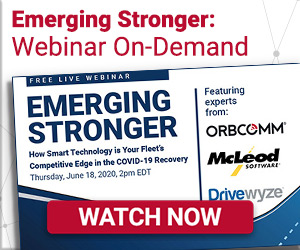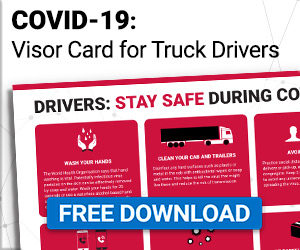
Drive Retention and Innovative Tech Key for Fleets
- Blog
- Transportation
- Drive Retention and Innovative Tech Key for Fleets
Every transportation business in the US and Canada has faced its challenges during the COVID-19 crisis. As fleets attempted to maintain a revenue stream, they were forced to amend employment procedures to combat virus transmission, change lane and trip policies and adjust to lower load availability and falling market rates. Yet throughout, transportation organizations and their drivers have played a critical role during the crisis in keeping food, pharma and other supplies moving, even as most other areas of business ground to a halt.
One of the more noticeable outcomes has been that fleets that turned to smarter technology during the pandemic have been quicker to bounce back. We hosted a panel of transportation experts in our recent webinar to find out how smart technology became a vital tool during these testing times and how it has been helping fleets to adjust to the new normal while remaining viable and profitable.
Here are some of the findings we learnt from our expert panel about how fleets can emerge stronger from the COVID-19 pandemic.
Technology to Stay in Touch
Technology is key at a time when we need to be more communicative than ever, without being able to meet and see anyone else. Through technology, fleets can reduce the points of physical contact between people, continue to ensure trucks are where they should be, monitor truck usage for proactive maintenance and keep communication lines open. Kenny Blankenship of Skyline Transportation said that for his fleet, although they had to shut the door to the drivers’ lounge, technology helped drivers to keep in touch and not feel isolated. Randal Sanchez, Solutions Architect with McLeod Software said that in utilizing existing technology, they were able to quickly pivot to online training instead of on-site.
Data-Driven Business and Processes
The Economist magazine recently announced that “the world’s most valuable resource is no longer oil, but data” and our webinar panel agreed that this is the case, especially in trying times. By leveraging the extensive data available to fleets, it was easier for fleets to understand their business and act on it. Data plays a part in every single aspect of fleet life, from who to partner and do business with, understanding revenue, ensuring compliance with HOS rules, and comparing work patterns and trends before and during COVID-19. Blankenship agrees that data is the most important piece of the puzzle: “The availability of data is huge today…”
ORBCOMM’s Chris MacDonald said that while he has seen just how critical that data is, actionable data is key. “From a fuel analytics perspective, understanding what your run rate is for fuel, where you see idle time and where you see costs savings and the same thing with detention. It may not have been that critical in the past, where your assets are and how long they’ve been there. Now people can react to them much more quickly because you don’t want to send a driver out to find a trailer that may or may not be there. We have to be able to give them this information quickly and accurately and have them act on it. And that makes the fleet much more efficient and if that makes them more efficient, it makes them much more profitable.”
Trusting in Great Partnerships
Collaboration, visibility and agility to make fast decisions were key components to ensure available data became usable data and as a result, success during the pandemic. Close integrations and partnerships were vital to that. Chris MacDonald says that he’s seen a move “towards more collaboration between partners. We’re seeing a lot of folks saying: move fast and partner wisely. What fleets want to see is collaboration across all channels. Whether it’s a partner or competitor, they’re looking for information as robust as they can get it, as fast as they can get it. I believe the agility of tech companies to show flexibility and speed not only to market but also with various offerings to customers, will really distinguish themselves. A lot of us had to prove ourselves over the last three months as we’ve gone through this.”
Blankenship backed that idea: “No one saw this coming. Maybe in December, did we expect it to be this? No. So no one was fully prepared for this and we had to use the data that was in front of us and I think those partnerships are what allowed us to do that.”
Look After Drivers and They’ll Look After You
Driver satisfaction and retention was also a key issue during the pandemic. Drivers were the ones keeping food on the tables and hospitals stocked with pharmaceutical products. It’s an important note that driver satisfaction features highly on any fleet manager’s agenda. Neil Fisher, VP Sales at Drivewyze said that some of the challenges are held over from before COVID-19. He said the focus on driver retention is as important as ever. Fleets still need to hire safe and experienced drivers to handle their freight and in turn, drivers want solid carriers to work for.
Blankenship outlined Skyline Transport’s guaranteed pay program for drivers which says if they turn up to work and do the work, they receive a fair wage, regardless of miles. “We had to be a good partner with our customers, but we’ve also got to be a good partner to our drivers as well. Because without those guys, it really doesn’t matter what technology we have in place because our truck is sitting still. We really found that our drivers appreciated that, and they really wanted that peace of mind”.
 Resilience and Learning from Mistakes
Resilience and Learning from Mistakes
The consensus is clear from our webinar: preparation is key. While no one had a blueprint for a pandemic, there are plenty of learnings to be had from the past several months. The advice is to create a playbook for the future to help companies to react in similar situations.
Blankenship said that COVID-19 made Skyline Transport step back to evaluate how they handle their lanes and asked a lot of questions in all areas of their business. “Do we take a shorter run that maybe helps us get in a better position instead of taking longer runs, or maybe we do two shorter runs and things like that. It kind of went against what we normally try to do for our drivers. Giving them long runs and less of them a week. Things like that, the change in the market really forced us into that situation. The swiftness that it moved, a lot of the time we see that market change coming, but with this, it went extremely fast. It went in a week or two, you saw a massive change in rates.”
These were just some of the takeaways from our webinar: Emerging Stronger: How Smart Technology is Your Fleet’s Competitive Edge in the Economic Recovery. To hear it all, you can watch the webinar on-demand now at this link.
If you have any further questions or comments, we’d be happy to hear them, simply add them in the comments below.
We’d like to thank our partners who helped us to create this webinar:
Kenny Blankenship, Director, Information Systems & Communications, Skyline Transportation
Susan Fall, PR, Launchit Public Relations
Chris MacDonald, VP & GM, Americas, ORBCOMM
Randal Sanchez, Solutions Architect, McLeod Software
Neil Fisher, VP Sales, Drivewyze

















